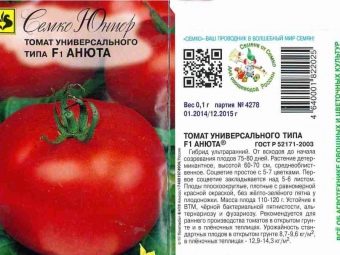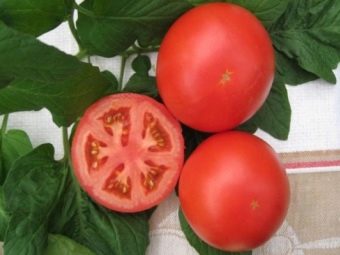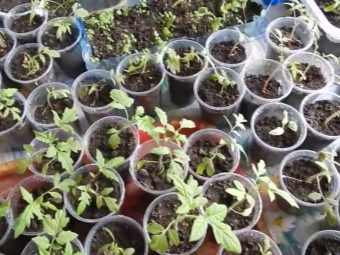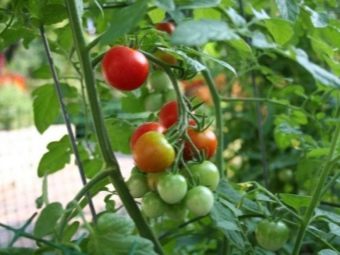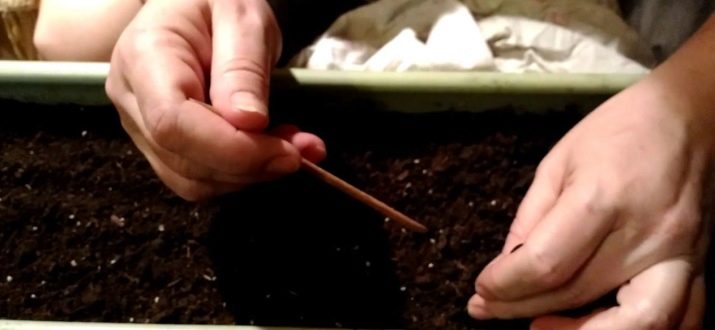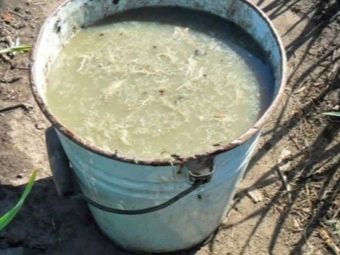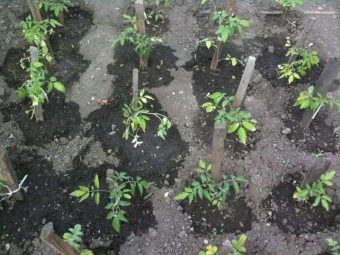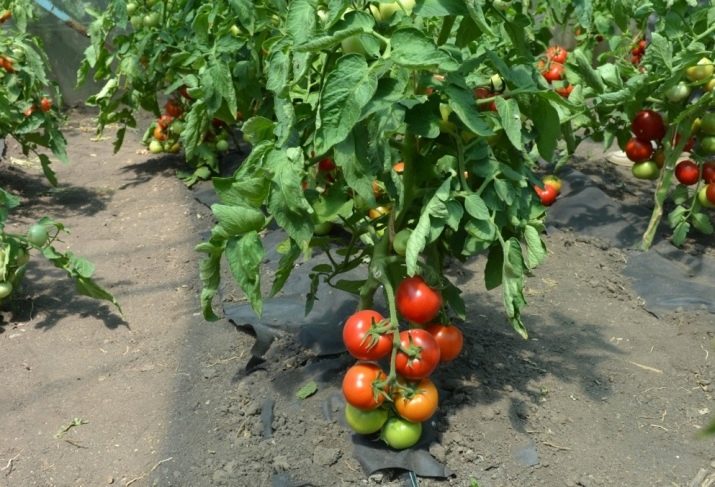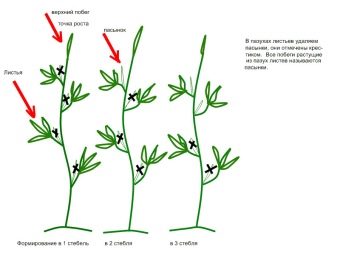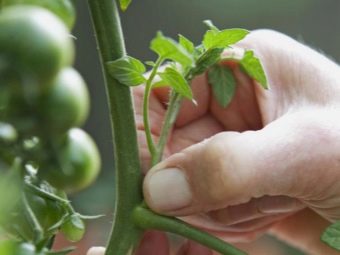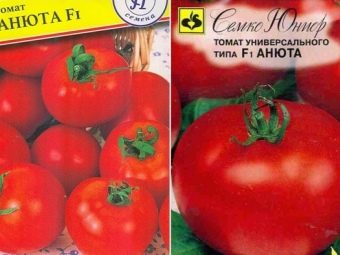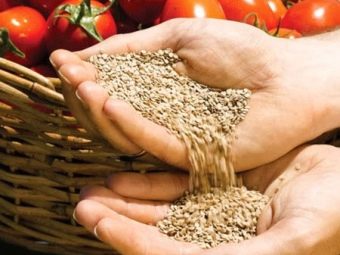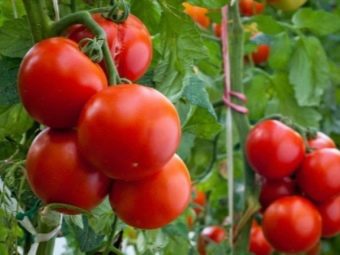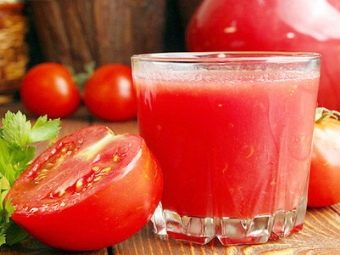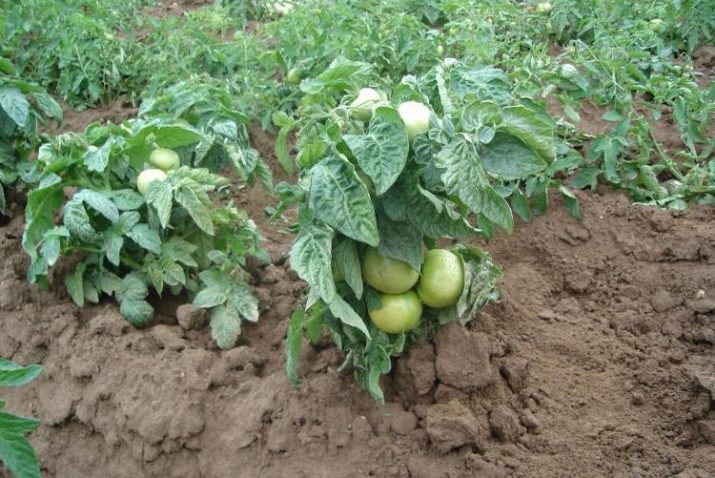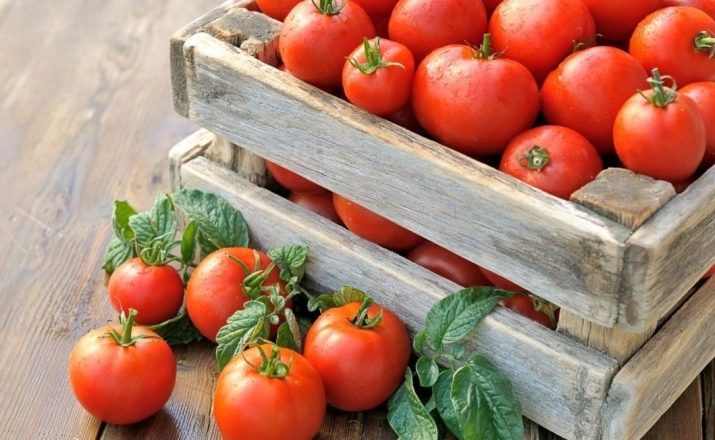Tomato "Annie F1": characteristics and yield of the variety
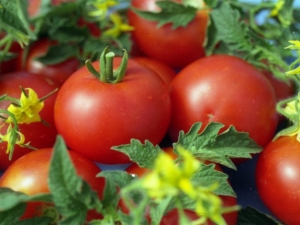
Tomato "Anyuta F1" is very popular among summer residents, especially for its extremely early ripening periods and reliability - stable yield and resistance to diseases. Now about everything in order.
Origin
"Annie" - a hybrid of the first generation of Russian breeding. This grade is patented by Semco Junior. In the description, the North Caucasus region, as well as the Rostov region and the Krasnodar Territory, are indicated as more suitable areas for cultivation, that is, there “Anyuta” will be able to grow and produce crops right in the open ground. But, from the experience of vegetable growers, it is safe to say that in greenhouses at summer cottages in the Moscow Region and other areas of central Russia, these tomatoes will also feel great, if, of course, they are provided with proper care.
Agrotechnology
Best of all, this variety, like all numerous types of tomatoes, is grown in seedlings. Seeds for seedlings can be sown at the end of March. The peculiarity of "Anyuta" as a variety of ultra early ripening is that during the summer season you can get several harvests if you sow another batch of seeds in May. In this case, the plants of the first crop will yield by the end of June, and the second - by the end of August, and during a warm autumn they will be able to bear fruit all September.
Cultivation conditions and care in general do not differ from agricultural techniques for other varieties.
Growing seedlings
Sow the seeds you need in containers with good drainage, filled with nutritious loose soil. Containers should be kept in a room with rather humid, warm (about + 23 ° C) air. Humidity of the substrate should also be maintained constant, for this you can, after good irrigation, close the container with a film that is removed when shoots appear.
When two true leaves grow, they carry out a pick. Before planting seedlings in a permanent place, it must be hardened, for which the temperature is reduced to about + 10 ° C at night and + 15 ° C during the day.
Transplant plants with 5-6 well-shaped leaves. It is better to do this at the beginning of June, when the probability of recurrent frosts is already small.
Transplant into the ground
When choosing a landing site, you need to think about the predecessors. The main thing for tomatoes is that this place before them is not home to “relatives” of the nightshade: potatoes, eggplants, peppers, and Physalis.
Tomatoes of any variety are sensitive to soil fertility and moisture, and "Annie" is no exception. Therefore, it is good if during the autumn digging organic matter was introduced (manure or bird droppings - 5-7 kg per m2), and immediately before planting, it is better to add mineral fertilizers in the required amount to the soil at the future site of cultivation:
- superphosphate - 40 g per m2;
- potash - 30 g per m2;
- Nitrogen - 30 g per m2.
And, of course, water well.
The planting pattern is 30x40 cm. This distance is sufficient, since “Anyuta” is a determinant variety, that is, with limited growth, therefore, most likely, adult plants will not be higher than 60-70 cm.
Care
This variety does not require over-care. However, it is necessary to regularly conduct watering and fertilizing. After 10 days, you can feed a solution of mullein (1 part to 9 parts of water), adding about 20 g of superphosphate to the bucket. Two more mineral supplements in a half dose against the one introduced during planting can be carried out at intervals of about 12 days. But if the plants are strongly drawn, it is better not to apply nitrogen fertilizers. You can also feed with ash, a solution of fermented grass.
To extend the terms of fruiting, apply fertilizing with milk and iodine.
Bushes respond that begin to form new buds and ovaries.
Top dressing can be combined with hilling. This technique allows plants to form a more powerful root system, since tomatoes are capable of forming roots along the whole stem and even on leaves under favorable conditions.
Plants of the “Anyuta” variety are usually low and rather strong, therefore they themselves do not need support, but in order for the stems not to bend or break under the weight of the fruits, it is better to tie them.Do it in two or three places as the stem grows.
A characteristic method for growing tomatoes is pasynkovanie. Everyone knows that in the axils of the leaves, tomatoes form side layers, stepchildren, which must be removed to increase the yield of the main plant. These branches are used in different ways. You can put in water for fermentation and then use as a fertilizer or pest repellent means for other plants. And in the case of "Anyuta" there is another option.
Since tomatoes of this variety begin to bear fruit very early, then with the free land, the stepchildren can be planted and several more full-fledged plants will be planted, which will also have time to harvest.
Vegetable growers recommend another interesting method of cultivation, which also allows you to increase returns. You can grow a plant on two roots. For this, two tomatoes are planted very close, the trunks of both are notched, put in places of slices and tightly tied. When they grow together, the harness is removed and the weaker top is cut off.
Diseases and pests
The variety of tomatoes “Anyuta F1” has spread widely due to the fact that it is very resistant to the diseases typical for tomatoes: late blight, tobacco mosaic and top rot. Pests are also infrequently affected, but for prevention, plants can be treated with fungicides. Ash or tobacco dust can also be used.
Seeds
When the variety is hybrid, the characteristics of the "parents" are unknown. Therefore, theoretically, seeds can be collected from the variety “Anyuta”, but in practice it is impossible to predict what plants will be produced next year, what fruits they will have. Therefore, if you want to grow tomatoes with exactly the properties of this variety, the seeds must be purchased every year from reliable producers.
Characteristic variety
If the necessary conditions for plants are created, by the end of June the first bright tomatoes will appear on them.
Fruit Description
Tomatoes varieties "Anyuta F1" can only be bright red, there is no spot on the stalk. The skin is thick and glossy. The fruits are round, slightly flattened form. On their brush can be from 5 to 7 pieces. Tomatoes are quite large, reach a weight of 120 g, do not crack if the plants receive the required amount of nutrients and moisture. The fruits are quite transportable, they can be transported over long distances. Well kept, the maximum shelf life in a cool dry place is 30 days.
Very early ripening of the variety involves the use of fresh fruits, most often in salads. But from the experience of vegetable growers who are familiar with Anyuta, it can be argued that these tomatoes are very good in blanks, both in salted and pickled form. And also from them it turns out tasty and healthy juice and sauces, which will suit many dishes.
Yield
"Annie F1" is a universal variety, that is, it can grow both in open ground and under film coating, as well as in greenhouses. But the yield may vary slightly:
- open ground - 8.5 - 9.6 kg / m2;
- greenhouse - 12.5 - 14.5 kg / m2.
That is all the same for a tomato like a thermophilic plant, the recoil on the protected ground will be higher. With one bush varieties "Anyuta" can get up to 3 kg of juicy tomatoes.
Reviews
Vegetable growers who have already grown these tomatoes have not found any significant shortcomings. Some people think that the taste is not very good, but this is explained by the fact that early varieties do not have time to “accumulate” enough sugars (the sugar content of Anyuta is about 1.6%, for comparison, for some other varieties this indicator may be 1, 5 - 2 times higher). This is perhaps the only minor flaw, which is more than compensated for by the mass of merits:
- very early ripening;
- high yield;
- the possibility of obtaining multiple yields;
- relative lack of care;
- resistance to diseases (even late blight, which is rare among tomatoes);
- density and good transportability of fruits;
- universality in use.
See the following video for the secrets of growing sweet tomatoes.

